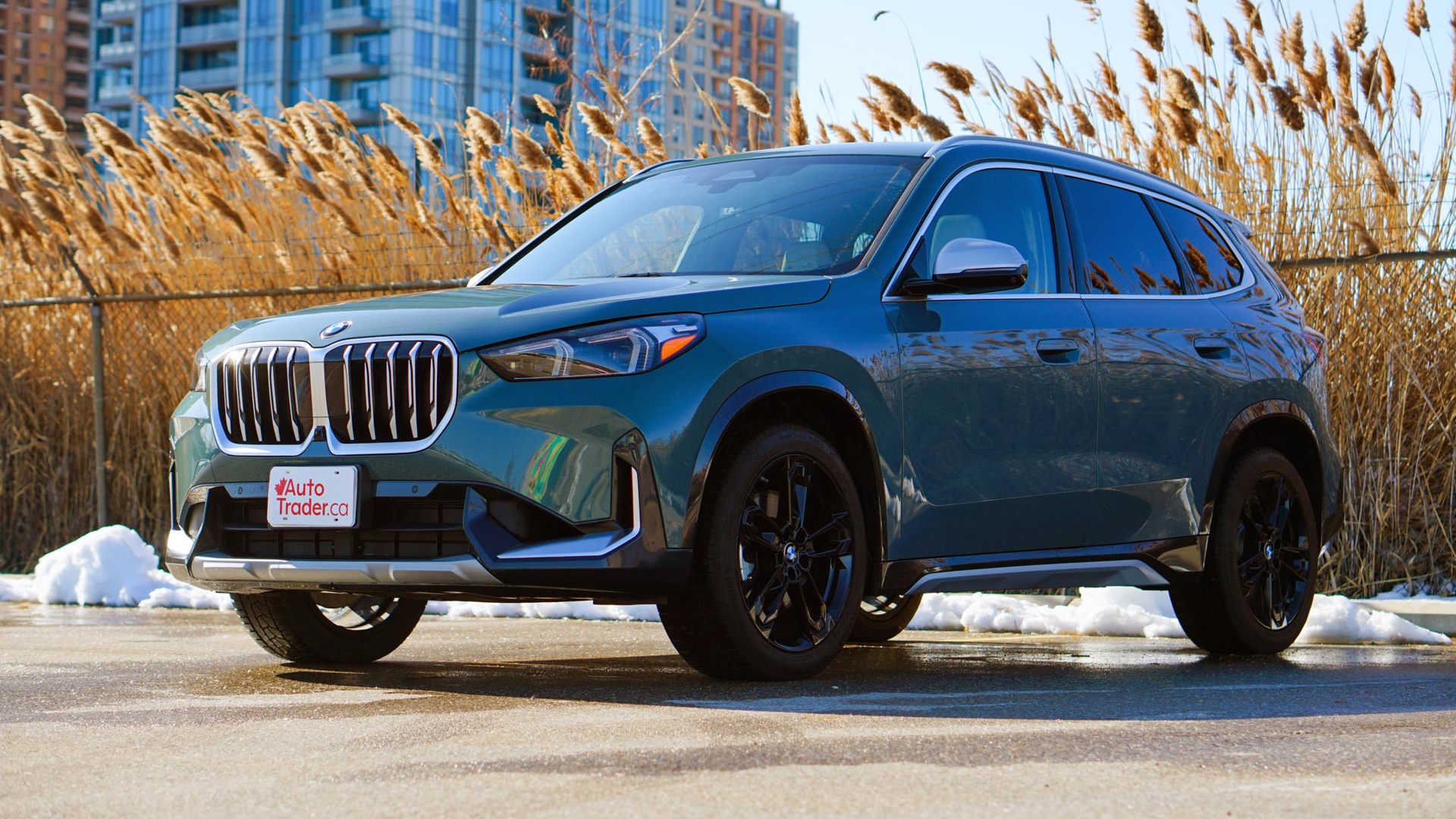 AutoTrader SCORE
AutoTrader SCORE
-
STYLING9/10
-
Safety9/10
-
PRACTICALITY9/10
-
USER-FRIENDLINESS8/10
-
FEATURES7/10
-
POWER9/10
-
COMFORT8/10
-
DRIVING FEEL8/10
-
FUEL ECONOMY9/10
-
VALUE8/10
The 2023 BMW X1 is the most affordable way to get into the automaker’s lineup.
As the brand’s entry-level model, it has a big responsibility to be a lot of things to a lot of people and deliver a true BMW experience at a price that won’t scare people away. And yet this third-generation version doesn’t feel like any corners were cut in spite of its entry-level roots, and it’s an excellent representation of what the brand is all about.
Style: 9/10
BMW nailed it with the redesign of this subcompact SUV. While the previous X1 could have been mistaken for a hatchback, this new model looks like the upscale SUV it is. The grille looks posh and gives off strong BMW vibes, the boxy and upright proportions look fantastic, and there’s something fresh about how the X1 presents itself.
The optional Cape York Green Metallic paint is also fabulous – it’s an $895 option that is worth every penny. It’s not quite green and not quite grey, but it has a subtle pearlescent shine when the light hits it just right. During my week with the X1, two passersby complimented the paint, and one of them told me it looked expensive.
The interior is also well done and feels like a BMW should, with the exception of some hard black plastic that’s prone to scratching. My passengers loved the standard ambient lighting, which has a purpose beyond simply looking cool. The lights will pulse if there’s an incoming call, for example, or if you try to exit the car while the engine is still running.
The different textures, smart build quality, and open layout all combine to make the cabin feel upscale. Style-wise, the X1 doesn’t look or feel like an entry-level crossover, and I wish BMW scaled up this exact design for some of its larger SUVs like the X7, because it’s that strong of a look.
Power: 9/10
The BMW X1 is powered by a 2.0L turbocharged four-cylinder engine with 241 hp and 295 lb-ft of torque. All-wheel drive is standard, along with a seven-speed dual-clutch automatic transmission. Officially, that’s enough to get this crossover from zero to 100 km/h in 6.4 seconds, but in practice, it’s plenty of power to pull off a convincing pass or to get up to highway speeds swiftly. One interesting note: there’s no park button – you simply turn the ignition off or apply the parking brake.
Driving Feel: 8.5/10
What stands out about how the new X1 drives is that all the mechanical elements work together seamlessly. The engine builds power smoothly; the transmission is quick, seamless, and intuitive; the brakes feel strong and responsive; and it all works together cohesively. The steering also feels predictable and has a nice weight to it.
The suspension might feel a bit stiff for some drivers, but the payoff in how well the crossover handles is worth it. The X1 feels like a hot hatch to drive and, in true BMW fashion, is confident and flat in corners, making its handling a highlight.
One complaint I have is that the ignition stop-start system feels rough and badly timed. It cuts the engine while you’re coasting to a stop, oftentimes when you’re not yet ready for it. Making the issue worse is that there’s no physical button to turn it off; drivers are forced to go into the touchscreen to disable it every time they get into the car because its default setting is on. One other minor complaint: the A-pillar is so thick that it creates a large front blind-spot for a vehicle this small, and there’s no small window near the side mirror to help.
User-Friendliness: 8/10
Besides those small gripes, the X1 is easy to live with. One of the biggest upgrades is that the SUV is running BMW’s most recent infotainment system, which has been streamlined with simplified menus. The new layout and simplified menus mean that finding what you’re looking for takes fewer taps and less digging, but I would find it even more helpful to have physical buttons and better shortcuts for climate control. I don’t like that you have to go into the touchscreen to turn on the heated seats and steering wheel, for example.
This is a rare BMW in that there is no rotary dial near the gear selector to control the infotainment system, so other BMWs are even easier to live with, especially because they have larger infotainment screens. I prefer having both a rotary dial and a touchscreen – the rotary dial is less distracting to use while in motion, and the touchscreen is better when you’re parked or can make a quick selection. One strange annoyance to note is that the X1 continues to play audio even after you exit the car, so I wound up having to rewind sections of my podcasts that I missed while unloading the trunk.
Practicality: 9/10
The X1 never used to strike me as a practical vehicle because of its small size, but BMW has surprised me by making practicality one of the SUV’s strong suits. The trunk holds a generous 728 L of cargo, which opens up to 1,620 L with the seats folded. The seats fold flat manually in a 40/20/40 configuration so the middle section can fold independently. This setup is so European and makes the X1 super practical because you can still fit skis or longer items inside while still having four full seats. The cabin also has tons of small item storage; there’s a huge open shelf under the centre console, and the door pockets are deep enough to fit a large water bottle.
Features: 7/10
The X1 has a new digital instrument panel and an infotainment screen that are housed under a single panel of curved glass. It cleans up the cabin considerably and gives the infotainment system lots of screen real estate to show useful information.
Wireless Android Auto and Apple CarPlay are standard and are well-integrated, so if you’re using Google Maps the navigation instructions will show in the gauge cluster screen as well as the head-up display. A wireless phone charger is also available, and the design struck me as odd at first, but it ended up being excellent. The charging cradle is upright and uses an arm to keep the phone in place. It puts your phone in your line of sight, meaning you can quickly glance at a notification without having to pick it up. It also makes it less likely you’ll forget your phone in the vehicle.
To keep that entry-level price appealing, BMW has sacrificed many features and has bundled them into expensive options packages instead. Even heated seats and a heated steering wheel aren’t included as standard, and those are two features that I consider essential, especially at this price point, so that’s a big disappointment. Many of the other novel features, like an integrated dash cam system, self-parking system, head-up display, sunroof, keyless entry, and interior camera are also part of add-on packages.
Safety: 9/10
Making those omissions a bit more palatable is the fact that the X1 now has more safety features included as standard that BMW used to charge extra for. Blind-spot monitoring with rear cross-traffic alert, lane departure warning, front and rear parking sensors, automatic high-beam headlights, forward collision warning with pedestrian and cyclist detection and automatic emergency braking, and safe exit warning, are all included now. Adaptive cruise control is optional.
Comfort: 8/10
The sporty suspension makes the X1’s ride a bit stiff, but not to the point where it becomes an issue. The supportive seats in the front help matters, but in the back they feel a bit flat and might get uncomfortable after a longer drive. There is decent head- and legroom in the back seats, however.
Fuel Economy: 9/10
The 2023 BMW X1 xDrive28i’s fuel economy is officially rated at 9.6 L/100 km in the city, 7.0 on the highway, and 8.4 combined of premium fuel. After 666 km (I’m not superstitious) of mixed testing, the X1 returned 8.2 L/100 km – impressive since it was riding on winter tires and it was a cold, snowy week.
Value: 8/10
The 2023 BMW X1 starts at $45,800 plus the non-negotiable $2,480 freight fee. As an entry point into the BMW brand, that’s an appealing price, but the lack of features that should come standard is a disappointment. This tester had a Premium Enhanced package I consider essential that adds $6,250 to the price tag. With a few more options added, the total came to $57,525 before tax, which takes it firmly out of “entry-level” territory.
The Verdict
The 2023 BMW X1 is a fantastic entryway into the brand. This subcompact SUV does everything a BMW should – it drives well, looks cool, and feels fancy inside, but it’s also surprisingly practical and easy to live with day to day. While it’s not perfect, it gets a lot right and is definitely a highlight in its segment. It’s an excellent, well-rounded small SUV that offers the full BMW experience at a reasonable price – at least until you start to add in essential features.
| Engine Displacement | 2.0L |
|---|---|
| Engine Cylinders | Turbo I4 |
| Peak Horsepower | 241 hp |
| Peak Torque | 295 lb-ft |
| Fuel Economy | 9.6 / 7.0 / 8.4 L/100 km cty/hwy/cmb |
| Cargo Space | 728 / 1,620 L seats up/down |
| Model Tested | 2023 BMW X1 xDrive28i |
| Base Price | $45,800 |
| A/C Tax | $100 |
| Destination Fee | $2,480 |
| Price as Tested | $57,625 |
|
Optional Equipment
$9,245 – Premium Enhanced Package, $6,250; xLine Package, $1,350; Open Pore Eucalyptus Trim, $250; 19-inch alloy wheels, $500; Cape York Green Metallic, $895
|
|
















































